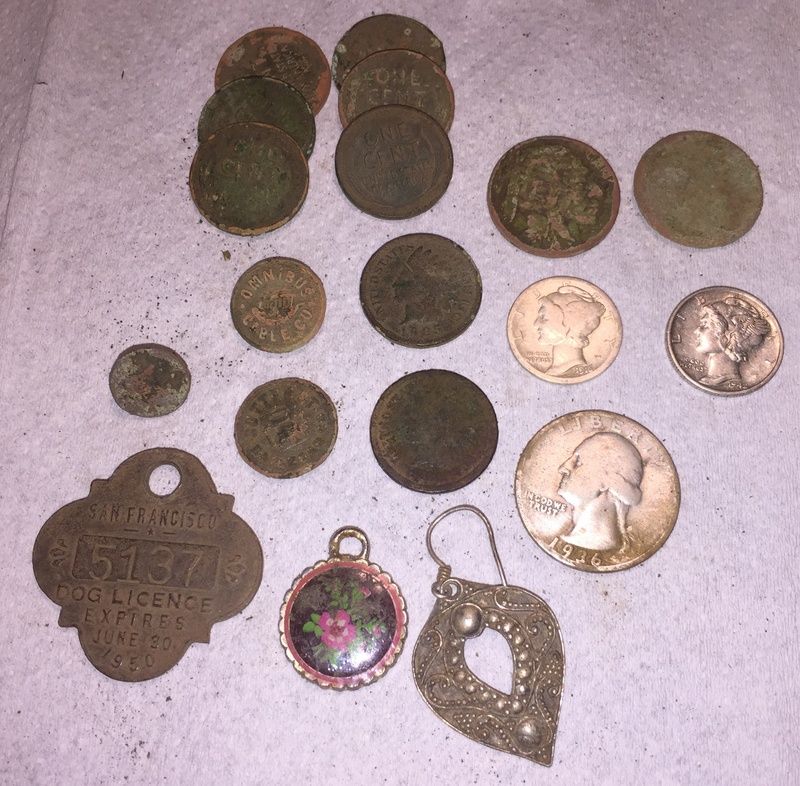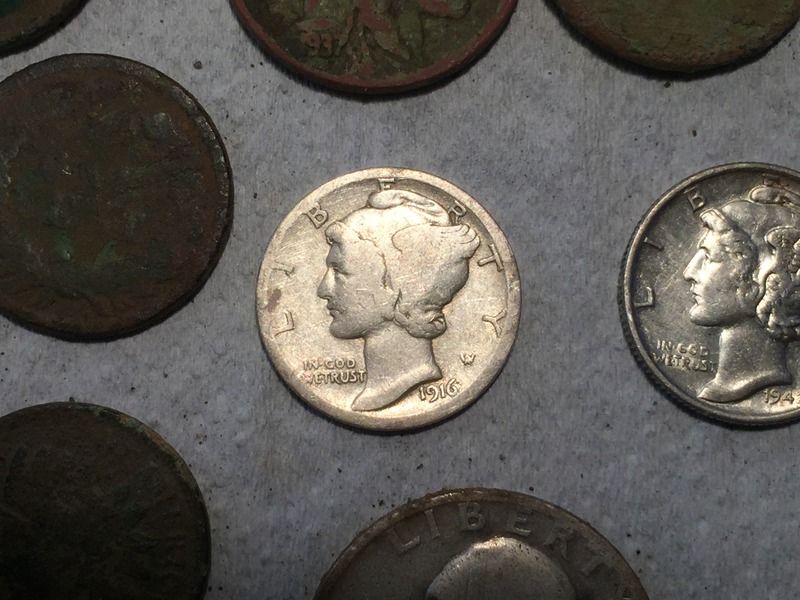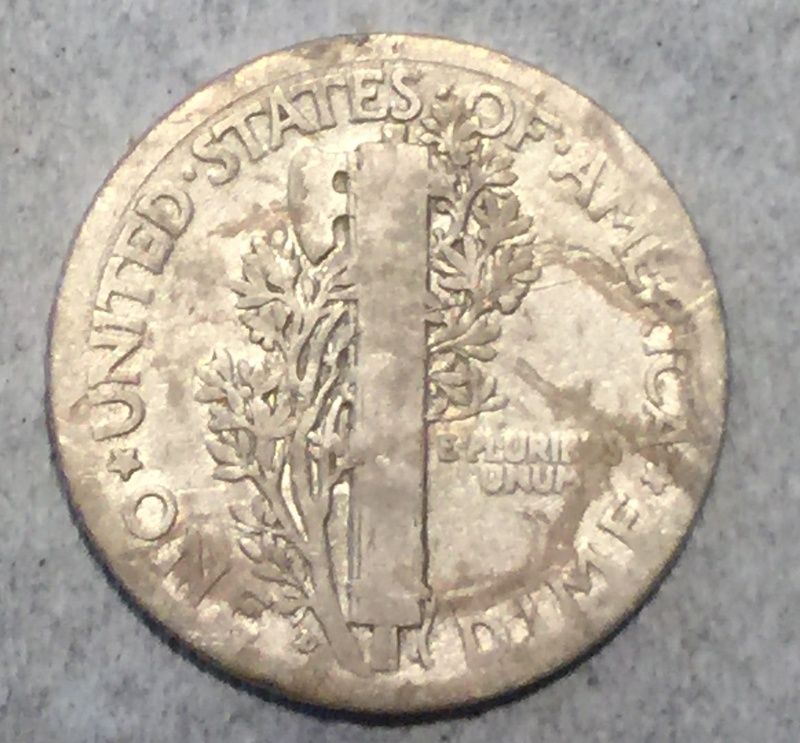Did some detecting this morning with my Racer2. Any time I'm able to get out anymore is great, and this hunt was (so I thought) shaping up to be an average hunt. I found six wheaties (1913S, 1923S, 1939S, 1941S, 1942S, and a no date), two Indian heads (1881 & 1905), a buffalo (1937), a toasted ?nickel?, a nice San Francisco dog tag, albeit some 54 years newer then the one I found a couple of weeks ago, a couple of pieces of .925 silver jewelry, two 1800's San Francisco Cable Car buttons (one from the Sutter Street Railroad with a train on it, the other from the Omnibus Cable Company, also with a train on it. Both would later merge into the San Francisco Cable Car system).
I also found three silver coins, two mercs and one Washington quarter. I generally don't look at the dates on my coins until I get home, so this morning after I got back from detecting I was checking out my finds, and the one merc was in beautiful condition, but it's a common date 1942S, the silver Washington is a 1936 with a big rust blotch on the back.
Then I looked at the last coin, a worn mercury dime, and I wasn't expecting much. I checked the date, 1916, OK, OK, I've found several 1916 mercs over the years and they've all been San Francisco or no mint marks. I muttered "come on, be a Denver mint mark" as I turned it over to check, and much to my amazement, IT'S A 1916D Mercury Dime!!



I still cannot believe I finally bagged a 16D merc I wish it was in as good of condition as the 1942S merc, but we take what we can get
Thanks for taking a look,
Brian
PS - A little history on the cable car buttons I found

THE OMNIBUS RAILROAD & CABLE COMPANY – 1889
The Omnibus Company was one of the earliest transportation systems in San Francisco, dating to 1861. Gustav Sutro owned the firm and in 1889 replaced the firm’s horsecar lines with cable operations. The company was the second largest cable system in the City, with 11.3 miles of rail, but was not successful. Electric Trolleys were improving rapidly and only eleven years after the line opened, all routes were eliminated or converted to electric streetcars.
The Omnibus Cable lines followed the pattern of the Market Street Cable routes, on less traveled streets however. Meager revenues forced the company to abandon the Howard Street line, from 10th Street to 26th Street, in 1893, after only four years in operation. Market Street Railway took over the failing company in October 1893 and promptly converted the cable lines to electric streetcars or closed them. The powerhouse at Oak and Broderick Streets in the Western Addition converted to electricity in 1895, along with the Oak and Ellis cable lines. The remnant of the Howard Street line, from the Ferry Building to the powerhouse at 10th Street stopped operating in 1899, as did the Post Street line.

HE SUTTER STREET RAILROAD – 1877
Henry Casebolt, another pioneer of urban transportation, operated horsecar lines in the City throughout the 1860s. In1876 Casebolt turned to cable cars to replace unprofitable horsecar lines.
Much of the Sutter Street Railroad was similar to the Clay Street system, with little innovation in the way of materials used or design. The one significant difference however, and Casebolt’s main contribution to cable railways, was a grip that grabbed the cable from the side, instead of below, while gripmen employed a lever to set the car in motion, rather than the hollow screw device patented by Hallidie for his Clay Street Railroad.
The Sutter Street Railroad, unlike the Clay Street line, ran over fairly level ground, and its steepest point had only a 4% grade. Converting the old horsecar line to cable was completed in 1876 and the line officially opened on January 27, 1877. Its cable cars ran on Sutter from Market Street west to Larkin Street. The cable line proved a tremendous success over its previous horsecar system, increasing its ridership by 962,000 in the first year of operation. In late 1878, the company opened a new crosstown line, which ran from the powerhouse, situated at Larkin and Bush Streets, south on Larkin to Hayes Street. The firm also extended the main line on Sutter Street further westward to Central [Presidio] Avenue in the Western Addition, which at that time was sparsely populated.
Casebolt sold out his company to a local real estate broker, Robert F. Morrow, in 1883. Morrow promptly began another extension of the line, on Larkin south across Market and down 9th Street to Mission. Morrow also abandoned the 1879 powerhouse at Sutter and Presidio Streets, in favor of consolidating all lines into a single powerhouse at Sutter and Polk.
The Sutter Street Railroad became the Sutter Street Railway in 1887, and the same year the company further extended the Larkin Street line south to Brannan. In 1888, the crosstown line pushed further from Polk Street to Pacific Avenue and west on Pacific to Fillmore Street. An overhaul of its whole system in 1890-91 saw an extension of the Pacific Avenue line west from Fillmore to Divisadero, giving the company a total of six miles of track, along with a mile of horsecar track that connected the Sutter Street line at Market with the Ferry Building.
The Sutter Street Railway operated until 1902, when it merged with United Railways of San Francisco, along with two electric streetcar companies and the Market Street Railway. Industrialists from the East Coast controlled this new conglomeration of transport in San Francisco until the Great Earthquake and Fire of 1906, when most of its cars, cables, and powerhouse were destroyed.
I also found three silver coins, two mercs and one Washington quarter. I generally don't look at the dates on my coins until I get home, so this morning after I got back from detecting I was checking out my finds, and the one merc was in beautiful condition, but it's a common date 1942S, the silver Washington is a 1936 with a big rust blotch on the back.
Then I looked at the last coin, a worn mercury dime, and I wasn't expecting much. I checked the date, 1916, OK, OK, I've found several 1916 mercs over the years and they've all been San Francisco or no mint marks. I muttered "come on, be a Denver mint mark" as I turned it over to check, and much to my amazement, IT'S A 1916D Mercury Dime!!




I still cannot believe I finally bagged a 16D merc I wish it was in as good of condition as the 1942S merc, but we take what we can get

Thanks for taking a look,
Brian
PS - A little history on the cable car buttons I found

THE OMNIBUS RAILROAD & CABLE COMPANY – 1889
The Omnibus Company was one of the earliest transportation systems in San Francisco, dating to 1861. Gustav Sutro owned the firm and in 1889 replaced the firm’s horsecar lines with cable operations. The company was the second largest cable system in the City, with 11.3 miles of rail, but was not successful. Electric Trolleys were improving rapidly and only eleven years after the line opened, all routes were eliminated or converted to electric streetcars.
The Omnibus Cable lines followed the pattern of the Market Street Cable routes, on less traveled streets however. Meager revenues forced the company to abandon the Howard Street line, from 10th Street to 26th Street, in 1893, after only four years in operation. Market Street Railway took over the failing company in October 1893 and promptly converted the cable lines to electric streetcars or closed them. The powerhouse at Oak and Broderick Streets in the Western Addition converted to electricity in 1895, along with the Oak and Ellis cable lines. The remnant of the Howard Street line, from the Ferry Building to the powerhouse at 10th Street stopped operating in 1899, as did the Post Street line.

HE SUTTER STREET RAILROAD – 1877
Henry Casebolt, another pioneer of urban transportation, operated horsecar lines in the City throughout the 1860s. In1876 Casebolt turned to cable cars to replace unprofitable horsecar lines.
Much of the Sutter Street Railroad was similar to the Clay Street system, with little innovation in the way of materials used or design. The one significant difference however, and Casebolt’s main contribution to cable railways, was a grip that grabbed the cable from the side, instead of below, while gripmen employed a lever to set the car in motion, rather than the hollow screw device patented by Hallidie for his Clay Street Railroad.
The Sutter Street Railroad, unlike the Clay Street line, ran over fairly level ground, and its steepest point had only a 4% grade. Converting the old horsecar line to cable was completed in 1876 and the line officially opened on January 27, 1877. Its cable cars ran on Sutter from Market Street west to Larkin Street. The cable line proved a tremendous success over its previous horsecar system, increasing its ridership by 962,000 in the first year of operation. In late 1878, the company opened a new crosstown line, which ran from the powerhouse, situated at Larkin and Bush Streets, south on Larkin to Hayes Street. The firm also extended the main line on Sutter Street further westward to Central [Presidio] Avenue in the Western Addition, which at that time was sparsely populated.
Casebolt sold out his company to a local real estate broker, Robert F. Morrow, in 1883. Morrow promptly began another extension of the line, on Larkin south across Market and down 9th Street to Mission. Morrow also abandoned the 1879 powerhouse at Sutter and Presidio Streets, in favor of consolidating all lines into a single powerhouse at Sutter and Polk.
The Sutter Street Railroad became the Sutter Street Railway in 1887, and the same year the company further extended the Larkin Street line south to Brannan. In 1888, the crosstown line pushed further from Polk Street to Pacific Avenue and west on Pacific to Fillmore Street. An overhaul of its whole system in 1890-91 saw an extension of the Pacific Avenue line west from Fillmore to Divisadero, giving the company a total of six miles of track, along with a mile of horsecar track that connected the Sutter Street line at Market with the Ferry Building.
The Sutter Street Railway operated until 1902, when it merged with United Railways of San Francisco, along with two electric streetcar companies and the Market Street Railway. Industrialists from the East Coast controlled this new conglomeration of transport in San Francisco until the Great Earthquake and Fire of 1906, when most of its cars, cables, and powerhouse were destroyed.



 ) 2016 turned out to be a darn good year of detecting
) 2016 turned out to be a darn good year of detecting